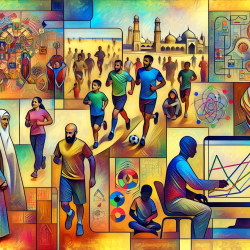Introduction
Physical activity (PA) is a cornerstone of health and well-being, yet its participation among Arab immigrants and refugees (AIR) in Western societies is notably low. A recent scoping review, "Physical activity participation among Arab immigrants and refugees in Western societies: A scoping review," sheds light on this issue, identifying both barriers and facilitators to PA among AIR. This blog aims to distill these findings into actionable insights for practitioners, emphasizing data-driven approaches to improve PA participation among AIR.
Key Findings from the Research
The review highlights a stark knowledge-compliance gap: while AIR generally possess sound knowledge and positive attitudes towards PA, their actual participation rates are low. In the US, only 11-22% of AIR engage in sufficient PA, compared to 26-45% in Europe. This discrepancy is partly attributed to environmental factors such as poorly maintained pedestrian and cyclist infrastructure in the US.
Barriers to Physical Activity
- Personal Barriers: Language illiteracy and limited PA skills are significant hurdles. These barriers are exacerbated by socioeconomic challenges like poverty and unemployment, which limit access to PA resources.
- Psychosocial and Cultural Barriers: Family responsibilities, cultural restrictions, and low social support hinder PA participation, especially among AIR women.
- Environmental Barriers: Poor infrastructure, lack of safety, and inaccessible community resources further restrict PA opportunities.
Facilitators to Physical Activity
- Improved PA Literacy: Training sessions and education programs in native languages can enhance PA skills and confidence among AIR.
- Social Support: Family and community support can significantly boost PA participation by providing companionship and encouragement.
- Culturally Sensitive Programs: Tailored programs that respect cultural norms, such as women-only sessions, can overcome cultural barriers.
- Infrastructure Improvements: Well-maintained pedestrian and cyclist infrastructure can facilitate both leisure and transport-related PA.
Recommendations for Practitioners
Practitioners can leverage these insights to develop targeted interventions that address the unique barriers faced by AIR. Collaborating with local communities to create culturally sensitive PA programs and advocating for infrastructure improvements can significantly enhance PA participation. Additionally, providing resources and training in native languages can bridge the knowledge-compliance gap.
Encouraging Further Research
While this review provides a comprehensive overview, there is a need for longitudinal and community-engaged research to further explore PA participation among AIR. Practitioners are encouraged to contribute to this body of research, helping to develop evidence-based interventions that can be scaled across different regions.
To read the original research paper, please follow this link: Physical activity participation among Arab immigrants and refugees in Western societies: A scoping review.










